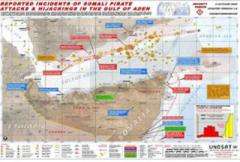Rough waters: Fighting modern-day pirates with technology

In the past year, maritime shipping has suffered a resurgence of piracy, at a level that the world has not seen since the early 18th century.
Sailors working off the Horn of Africa have been particularly hard hit: last year, records show that 125 ships were attacked and 45 seized.
Real numbers are likely much higher, as piracy is believed to be widely under-reported. One of the world's busiest shipping lanes, about 20,000 ships annually pass through the Gulf of Aden on their way to and from the Suez Canal — carrying a tenth of world trade.
Unlike the popular image of pirates seen in movies and books, modern pirates are more likely to wield machine guns than muskets; and the crime remains as difficult to fight as it ever did. Piracy is an extremely profitable and attractive occupation in a region characterized by lawlessness, bringing in multi-million dollar ransoms for the release of hostages, ships and cargoes.
Piracy has nearly cut off humanitarian aid deliveries to Somalia and has caused shipping insurance rates to skyrocket. Regional economies suffer as ships increasingly choose to go around the Cape of Good Hope. Given the number of oil tankers in the region, it seems only a matter of time before we see an environmental disaster of the Exxon-Valdez scale.
However, just as technology may have helped to promote the fall of the Robert Louis Stevenson-type of pirate, say historians (increased size and speed may have helped merchant vessels evade pursuing pirates), there is hope that technological advances will help protect cargos, vessels and crews.
Unosat aids monitoring, tracking and evading
Satellite-based maps produced by using grid technology are one promising anti-piracy tool. Different versions of these maps can tell the location of reported incidents and when they occurred, the identity and location of highjacked vessels, and the geographic areas with the highest density of attacks — accurate to within 100 meters. Some are offered in 3-D imagery.
UNOSAT, a co-operative project between the United Nations Institute for Training and Research (UNITAR) Operational Satellite Applications Program, and the European Organization of High Energy Physics, delivers satellite images to relief and development organizations. For the past five years, UNOSAT has worked on Somali-related security and humanitarian issues; it has monitored Somali pirate activity since last June as part of a UN Security Council resolution.
Typically, computer-intensive UNOSAT raw images are transferred to EGEE, where programs heavily compress satellite images for transmission over low-bandwidth connections, allowing users to access the latest maps from devices as simple as mobile phones. In this way, merchant ships, for example, can avoid areas where the latest assaults have been reported, and military vessels can know where to deploy.
Later this month, UNICRI, the UN's research organization for pirate-fighting, will hold its 'Stakeholders Meeting on Maritime Piracy on the Somali Coast' on 28 January. This meeting will gather those affected and outline hoped-for practical outcomes.
On the web: unosat.org/
The story is written by Danielle Venton of EGEE (Enabling Grids for E-sciencE www.eu-egee.org/ )
Provided by International Science Grid This Week (www.isgtw.org/)





















